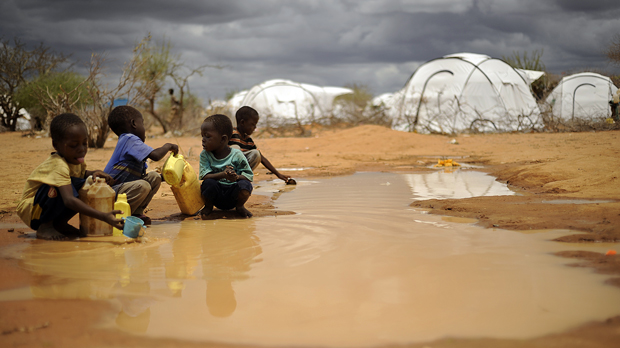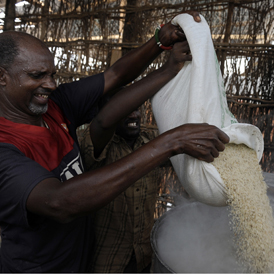Life on the edge for Dadaab’s refugees
Life in the world’s biggest refugee camp, at Dadaab, Kenya, means subsisting on the bare essentials. But people still try to live as normally as they can, writes the World Food Programme’s Steve Ryan.

When I left my comfortable ITN office in London and started working with the UN World Food Programme in Dadaab, Kenya – “the world’s largest refugee camp” – I quickly realised how ignorant I was.
How can someone walk from Somalia to here without any food? Why are people starving and yet there are so many goats everywhere? What do you actually give to people?
If you’re lucky enough to find the small food handouts on the way, you just might make it.
The relatively rich and poor live side by side in every city; here is no different.
Basic commodities to sustain life. If it’s too nice, as one aid worker warned me, there’s no motivation to move on.
The boy was illiterate and innumerate. He didn’t know how many drinks we’d taken, what it said on the crumpled notes we handed him.
My initial view was tainted by observers who criticise the UN. But a modern take on the “great game” aside, what does “aid” really mean?
Even in my short time here, I see that this is an incredibly complex undertaking. I’ve smelt the dust kicked up when transporting huge quantities of food over thousands of kilometres, constantly balancing the weight of the truck against the sand under its wheels.
I’ve watched relief workers calculate how to sustain the long-term refugees and yet still save those just arrived.
I’ve listened to nutritionists debating how to deliver the required minimum of 2,100 calories per person per day.
And I’ve shared the heat, albeit briefly, with thousands of refugees being finger-printed and given ration cards which enable them to claim supplies depending on family size.
The needs of fewer “family size 10s” are weighed against the numerous lone beneficiaries at the huge food distribution centres, which are secured behind coils of razor wire. Each kilogram of food is painstakingly accounted for, each movement reported back to Nairobi.
It is a significant feat, and I cannot help but be deeply impressed by the team here.
The Dadaab Refugee Camp
– In north-eastern Kenya, the Dadaab camp is home to over 340,000 refugees, mainly from Somalia. It was initially meant for just 90,000.
– Around 200-300 new arrivals come to the camp every day, many of them escaping the civil war in neighbouring Somalia.
– The camps have existed since 1991 and were meant to be a temporary solution to the Somali refugee situation.
– Since the start of the recent drought affecting the Horn of Africa, there has been a significant increase in the number of people arriving at the camp so an extension had to be built in summer 2011.

Some memories will stay with me, I hope, for a long time. But these have also posed new questions.
We stopped our vehicle to buy some lukewarm drinks from a young roadside entrepreneur sat on a coolbox. The boy was illiterate and innumerate, he didn’t know how many drinks we’d taken, what it said on the crumpled notes we handed him or even what giving change meant.
In the end we left slightly more refreshed in the 40 degree sunshine, and he had money in his pocket. But I couldn’t help feeling that despite his valiant efforts, his future was not certain.
How could we help him? What’s the story behind a simple entry in a reception centre log book: “unaccompanied child”?
We often hear about the “dignity” or “desperation” of refugees. These descriptions are accurate, but I also see people just getting on with things.
There are technical criteria for what we term a famine (a mortality rate of two deaths in 10,000 people per day, acute malnutrition rates of 30 per cent or higher, and at least 20 per cent of households facing extreme food shortages with a limited ability to cope). But if a crisis lasts 20 years, then it is no longer really a crisis.
What I see are people trying to live their lives as normally as they can – but it’s life at the edge. It’s different to a long queue at a supermarket checkout which used to make me curse under my breath.
Next time I’m lucky enough to be in one, I’ll remember these moments and put the literal meaning of “life” back into perspective.
Steve Ryan is a security consultant with the World Food Programme